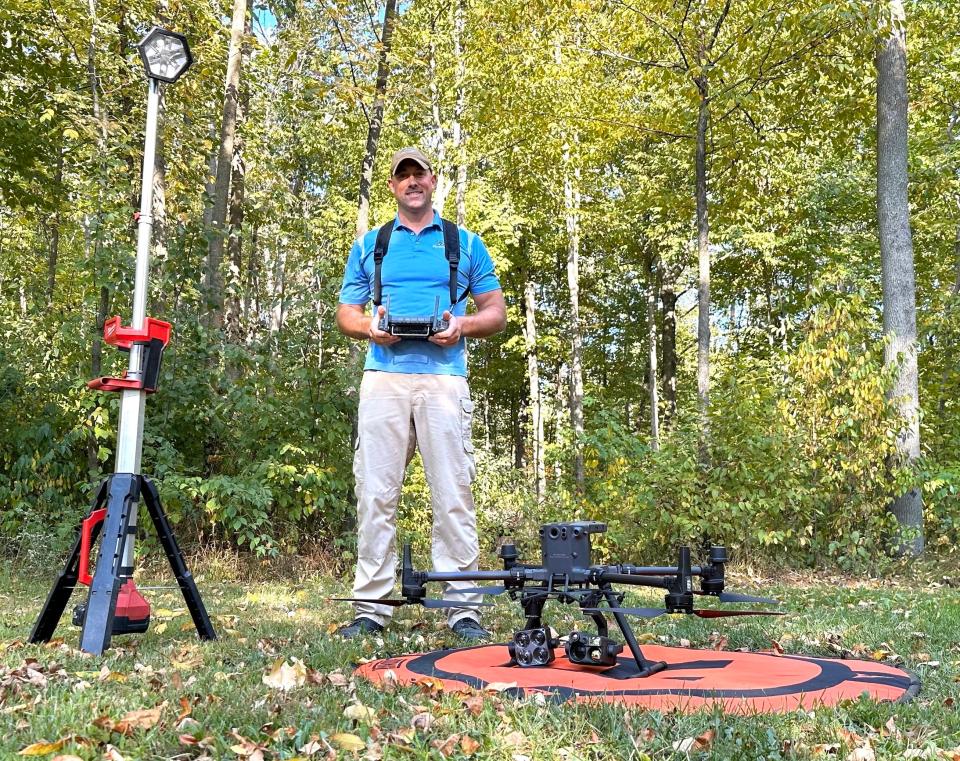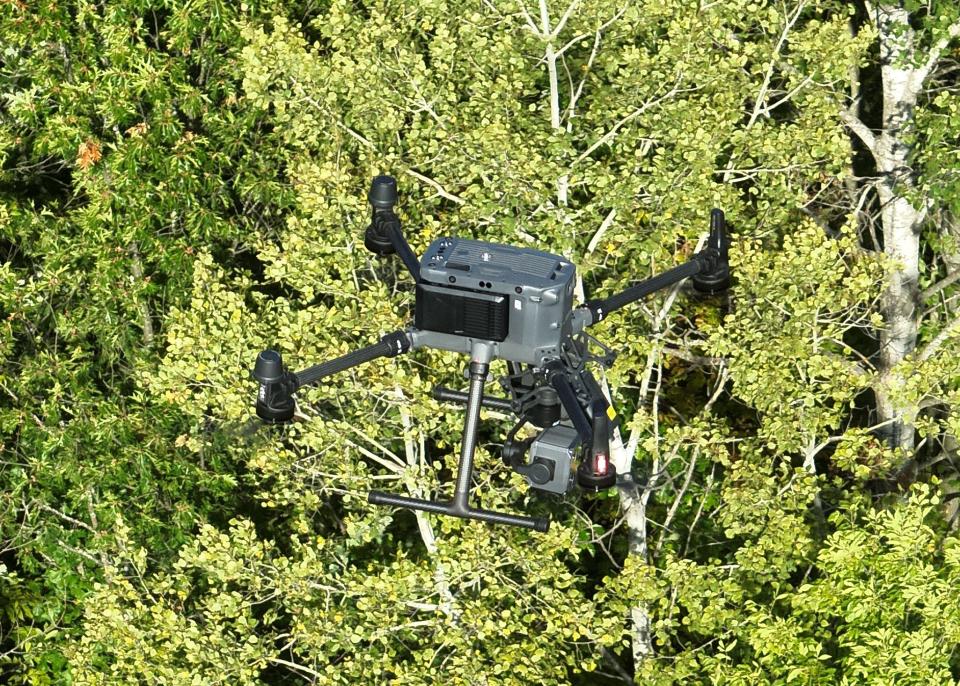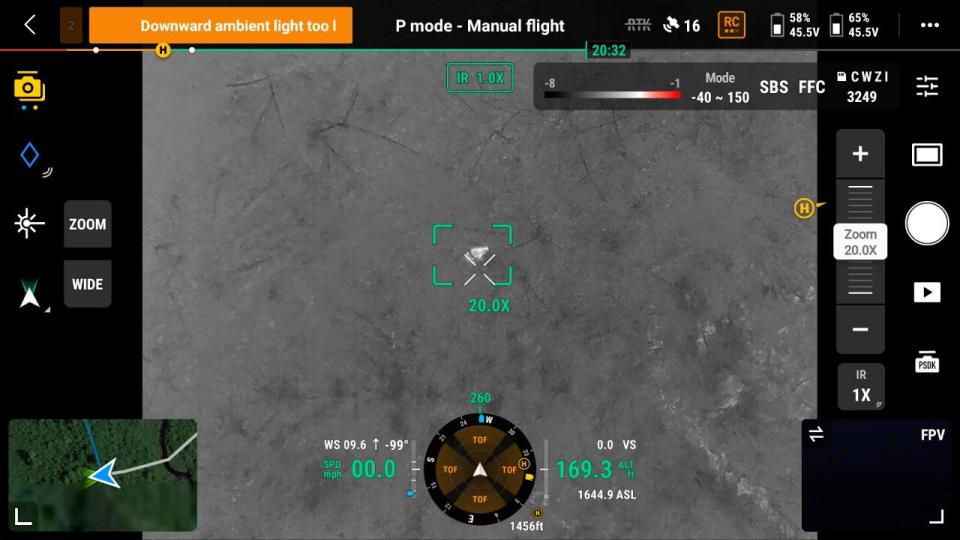Smith: Drones aid hunters in deer recoveries, heighten law enforcement scrutiny of UAVs

Illuminated by a bright light, a drone operator stood in a clearing of a Wisconsin forest and powered up his unmanned aircraft system, or UAS.
A group of hunters watched intently from several feet away.
Within moments the drone lifted off of its pad and gained elevation in the night sky.
The operator sent the device several hundred yards away until it was over the site of a tree stand used by one of the bowhunters, then in the direction a white-tailed deer ran after it was shot several hours before.
A thermal camera on the drone transmitted live video to the controller's display.
Within minutes the heat-sensing technology proved its worth. Amid a dark gray tangle of vegetation, a white, motionless figure glowed on the digital screen.
"There it is," said the controller. "There's your buck."
The scene from the 2022 Wisconsin bow season, relayed by a drone operator who requested anonymity, represents the latest trend in the age-old human endeavor of game recovery.
Students in hunter education classes are taught to follow blood trails to locate shot animals. Some dog handlers also use man's best friend to aid in the process.
But there's been a recent spike in the use of high-tech drones to find downed game, especially deer.
"The interest is surging, big-time," said Nick Wayerski of Marshfield, a licensed drone operator and owner of Marshfield Drones.
Wayerski, 40, said his company does most of its business in commercial applications such as inspecting cell towers or buildings.
But he and an associate make time in fall to work on deer and bear recoveries.
Demand for drone-assisted game recovery has at least doubled each year over the last four years, Wayerski said, and Marshfield Drones did 65 recoveries in 2022.
The practice is legal within a strict set of parameters.
"It's not as simple as just buying the right technology and finding your deer," Wayerski said. "To stay legal, you've got a bunch of things to know and follow."

Wayerski, a U.S. Marine veteran who after military service studied IT and started the drone company, believes he is the first Wisconsin resident to use a drone to recover a deer. It took place nearly five years ago after his nephew shot a deer near Pittsville.
It worked, and Wayerski subsequently refined his skills and equipment. In the process he's earned a national reputation as a leader in drone use for finding dead game. In recent years he's trained drone operators from several other states; all were focused on starting game recovery businesses.
Wayerski said the main reason he got into deer recovery is he was volunteering more and more of his time assisting local law enforcement in search and rescue for humans.
As a result of that work he acquired several thermal drones. Now he uses the same equipment to look for dead deer that he uses to help law enforcement look for lost humans and pets.
The increasing use of drones for game recovery has drawn the attention of Wisconsin conservation wardens.
The Department of Natural Resources recently updated LEH 750, a directive on enforcement of laws and rules related to drones in the agency's law enforcement handbook.
To stay legal in a game recovery scenario, it's critical for drone operators to understand several state laws and rules. For starters, it's illegal to hunt with the use of a drone.
"No person may hunt any animal with the aid of an aircraft, including the use of an aircraft tospot, group or drive, or otherwise attempt to affect the behavior of, animals for hunters on theground," the law reads.
The law is designed to prevent unfair or unethical hunting practices. Examples include spotting game from the air and driving or herding game with the use of aircraft, said Tom Hansen, DNR administrative warden.
Hansen said wardens use the "totality" of information when deciding whether to issue a citation.
But to avoid the appearance of using the drone to aid in hunting, the DNR's directive recommends: a reasonable but unsuccessful effort was first made to locate the animal without the aid of a UAS; an articulable explanation why they believe the wild animal is dead (e.g., well-placed shot into the chest cavity); the operation of the UAS does not occur during the shooting hours for the animal being sought; and none of the parties present during the flight or subsequent recovery efforts are in possession of a firearm, archery equipment, crossbow, or other weapon legally capable of reducing an animal to possession.

An example of a violation would be if the deer is found by the drone but still alive and a hunter used the location information to continue hunting the animal.
Hansen, who volunteers as a hunter education instructor, said he had a personal concern that hunters might start taking poorer shots at animals thinking they could rely on the drone for recovery.
"Every time you add new technology it raises new questions," Hansen said. "Drones can be helpful but it's critical to make sure people remain legal and ethical in their hunting activities."
Due to the laws and rules regarding drones, Wayerski said he never buys a bow license and only conducts game recovery for animals he can't legally hunt.
Marshfield Drones charges $250 to look for an animal and $100 if it's found. It only accepts jobs within a 30-minute drive of Marshfield.
Wayerski said he puts revenue from game recovery work into upgrading his search-and-rescue equipment.
The heat-sensing drone technology is extremely sensitive. Wayerski said they've found dead deer two days after they were shot even on frost-covered ground.
The average time to find a dead deer is 30 minutes, he said, but they have found them as fast as 37 seconds.
As of last week, Wayerski had done two bear recoveries, including one near Cadott that took 9 minutes, 34 seconds.
The use of drones is drawing more licensed operators to the game recovery business. An Ohio-based company called Drone Deer Recovery is franchising game recovery in multiple states, including several first-year operators in Wisconsin.
Wayerski said he shares what he's learned with other operators to help them build skills and keep them legal.
Since drones can legally and ethically help hunters recover shot animals and prevent game from being wasted, he said he plans to stay in the game recovery business.
"I love to track animals, I love the outdoors, I love putting more money into my search and rescue equipment," he said. "I plan to stay on the cutting edge of drone technology and keep helping hunters who need it."
Smith: For Wisconsin birders, 2023 has been a year of ‘celebrity’ sightings
Smith: Founded on hope, International Crane Foundation is a 50-year global success story
This article originally appeared on Milwaukee Journal Sentinel: Drones with thermal sensors help hunters find downed deer

